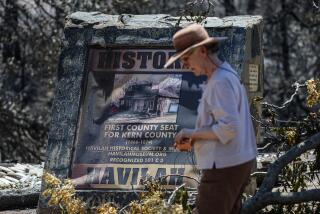A New Lease on Life : Volunteers Toil to Restore 4 Buildings From Town’s Past for Fillmore Historical Center
FILLMORE — Sitting on a scaffold about 15 feet up, 64-year-old Marlene Lowe fiercely scrapes the peeling white paint off the redwood building.
Her blue jeans are covered with dust and her red sweater is sprinkled with white paint particles.
“It’s tough work,” the Fillmore resident says, “but we have a dream, so we must continue.”
Lowe is one of about 50 Fillmore Historical Society members who spend Saturday mornings, and any free time during the week, salvaging four buildings previously targeted for destruction.
The group of mostly untrained volunteers, who make up for their lack of experience with zeal, hope to turn the run-down buildings into a historical center along the railroad, near Fillmore’s Central Park.
Their renovation projects include a 1905 Victorian-style house, a tiny, 1880 U.S. Post Office that until recently was someone’s back-yard shed, a 1919 bunkhouse that was used by workers at Rancho Sespe, and the 1887 Southern Pacific railroad depot, which was severely damaged in last year’s Northridge earthquake.
After each building is refurbished, it will be opened to the public, displaying items that reflect the history of the Santa Clara River Valley, said Jim Faris, president of the organization.
“We want to preserve our history and make it available to the public,” Faris said. “It’s important that we do that before everything is destroyed.”
The society launched the project in 1990 after it had saved about $100,000--money members began putting away in 1971 through fund-raisers and investments, Faris said.
At first, the project involved only the depot and the 1905 house, which had been the home of Fillmore’s first dentist, Ira Hikley. But as time passed, the society decided to rescue the other two buildings as well.
The bunkhouse, which until July was on its original site at Rancho Sespe, was on a list of buildings to be destroyed. And the one-room post office was found by a society member in someone’s back yard.
“We just couldn’t let those things go,” Faris said.
Within the next two months, the society hopes to finish restoring the Hikley house and to begin the tours there. It also plans to open a gift shop in one of the home’s rooms.
Although renovation of the two-story, 4,620-square-foot bunkhouse is at an early stage, the society plans to use the building as a historical library and office as well as museum, Faris said.
The depot will display artifacts that explain how freight and passenger trains operated. Near the depot will be a restored caboose, a boxcar and a red brick outhouse.
The society’s project coincides with Fillmore’s efforts to rebuild downtown and attract tourists to the tiny agricultural community.
A brick town-square plaza is half complete, and construction of a 15,000-square-foot City Hall began Monday.
The historical society rented from the city a quarter-acre lot near the new City Hall, where they are placing the four buildings that will make up the historical center.
Nearby are several restored trains that belong to Short Line Enterprises, which offers rides from Fillmore to Santa Paula.
Fillmore City Planner Anthony Perez said the historical center is an important part of the city’s overall vision for its downtown.
“We’re pretty lucky that the historical society managed to save four original buildings,” Perez said. “The city wants to make people feel like they are back in the late 1800s when they visit Fillmore, and the historical society museum will be a big part of that.”
But it’s still a long way before the bunkhouse, depot and post office are renovated, and the society is in desperate need of help, said Rita Rudkin, 46, a volunteer who has done everything from painting to dismantling walls.
“A lot of this is new to us,” said Rudkin, a farmer and retired nurse. “The work can be tedious and we have a lot of learning to do, but it’s the end result that matters.”
Last Saturday, Rudkin and a half-dozen volunteers put on goggles, rolled up their sleeves and went to work. The almost musical rhythm of paint being scraped echoed loudly as workers swarmed the redwood walls of the bunkhouse.
In previous weekends, the crew washed the walls of the house--which stood empty for 20 years--and removed the partitions that made the rectangular building into 40 small bedrooms.
It took the society 12 hours one summer night to move the bunkhouse downtown from Rancho Sespe, about three miles west of Fillmore.
“It was a nightmare,” Bud Lowe said. “We had to do it at night because of government bureaucracy.” Moving the house during the day could have been dangerous to traffic on California 126, he said.
The society plans to paint the bunkhouse and renovate its floor in the next few weeks.
Although only a few people in the group have knowledge about refurbishing old houses, members have found help and advice throughout the community.
“If it weren’t for the help of people all over town,” Faris said, “we wouldn’t be able to do what we have done.”
More to Read
Sign up for Essential California
The most important California stories and recommendations in your inbox every morning.
You may occasionally receive promotional content from the Los Angeles Times.










